This guide breaks down the ultimate strategies to gain clients like the top firms do.
And it is completely free.
By selling bean bags across Australia (And overseas) we have worked with countless architects and design firms for years.
Working with these leading firms has led me to discover the ‘secret sauce’ of what makes a successful business grow year-on-year.
Best part, these discoveries I’m going to share with you today can be implemented right now.
• With a $0 budget.
• Zero connections in your industry.
• And even with a brand new business.

Here is a taste of what you will discover:
• How to define your “Ideal Client”. Don’t work with frustrating people again.
• How to use other people’s networks. And create a steady flow of work forever.
• How to easily build a network of highly influential people recommending you.
This is a huge post, so I have created a table of contents to skip to any section that excites you the most.
NOTE: If you can, scan from start to finish so you won’t miss all the valuable gems along the way.
TABLE OF CONTENTS:
1. 3 ways you can grow your business right now
2. The most powerful marketing strategies you can implement now
3. How to discover your ideal client … And find more of them
4. Craft your story to sell for you
5. What you can learn from an old beer company to stand out from the crowd
6. Crafting the best lead-generation tool
7. Blogging – But not like you think. When time spent writing means money now
8. Using relationships in your industry to earn more today
9. Doing pro-bono work to directly earn more
10. How to campaign and win industry awards
11. Social media marketing for architects and designers
12. Understanding the “Pillars” that hold up successful firms and how to copy them
#1. 3 ways you can grow your business right now
There are only 3 ways to grow your revenue per annum and here they are:
1. Get more clients/projects
2. Get those clients to buy more from you within a year.
3. Get those same clients to give you more money per project.
There is no other way to generate more revenue for any business than that.

The simplicity of this truth is where it gets really exciting.
Say after reading this post you implement the strategies found below and you spend a little time on each of these 3 ways to grow your business.
So, after a little time you have:
1. A 10% increase in clients within a year.
2. 10% of your clients come back for more work from you (10 % repeat business within a year).
3. You simply increase your prices by 10% or offer a product or service that 1 in 10 of your clients’ purchases.
You won’t just grow your business by 10%, rather this means a 33% increase on the bottom line.
This is what will happen (As a basic example below):
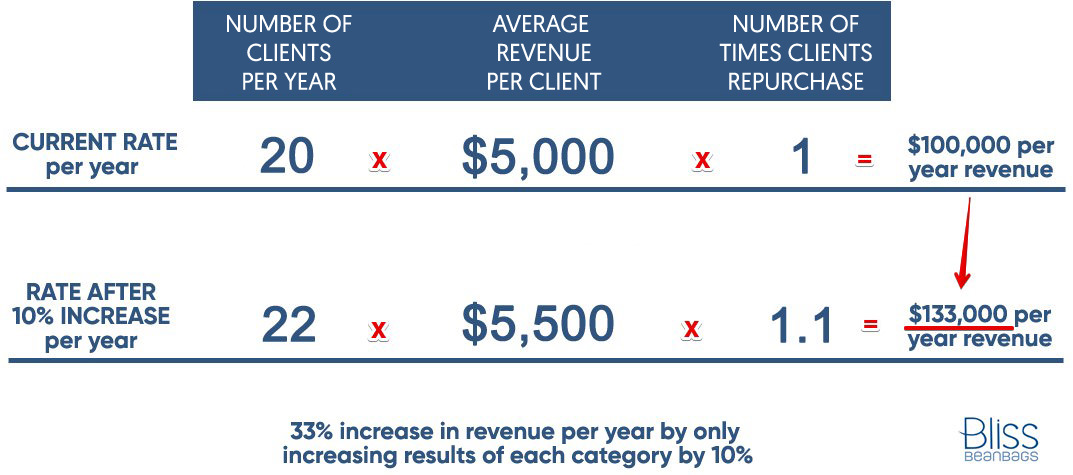
And if you create a 20% improvement in each of these 3 ways…Well you might need a bigger office.
NOTE: From my experience a lot of creatives feel that they won’t see a client again after a brief has been completed, so “repurchasing” isn’t really an option.
However, by using Host-Beneficiary partnerships explained below, you will find plenty of ways to help your clients and have then repurchase frequently.
#2. The most powerful strategies you can implement now
Out of the three ways to grow your business, let’s first look at number one on the list which is getting more clients.
The most powerful tactics to gain more clients with the lowest cost are through:
1. Content marketing
2. Social media promotion
3. Host-Beneficiary partnerships.

Before we discuss this in detail, we need to setup a little ground work so that you have a crystal-clear idea of what you want for your business.
After reading the next section you will be absolutely clear on what you need to do in order to boost your business a minimum of 10% in each category.
Let’s have a little fun laying the ground work:
#3. How to discover your ideal client and find more of them
Dream clients: Those that pay their bill on time, trust you and provide you with the best canvas to work your magic on.
Before crafting a precise plan to track down the client you actually want, you need to think about the similarities your ‘dream’ clients have in common.
This is vital to your brand and it will save yourself a huge amount of time when it comes to the marketing strategies laid out below.
In order to do this, imagine the best client you have ever worked with.
Now list the answers to these questions below as if this client was answering them for you:

• What Job(s) do they want done?
• How do they behave when it comes to your suggestions?
• Do they require help with small or large projects?
• What style are they drawn to?
• What are their interests/hobbies?
• What demographic and income bracket do they fit into?
• What do they value most in life?
• What are their greatest concerns when it comes to new work being done?
Include as much detail as possible so you have a deep understanding of who they are.
From questions such as these you will come up with a “Persona”.
(If you would like to explore how to create a persona in even greater detail check out this article when you have a chance)
When you have answers to these questions, you can create a little board such as the one below to represent your ideal client.
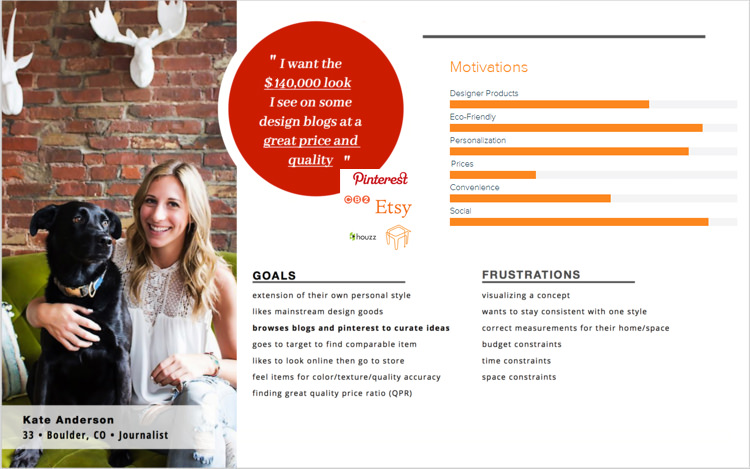
And finally have a look at the websites of famous designers or firms that you desire to be like. The ones that also serve your ideal client.
Are there common words they use on their website?
Such as, honesty, budget, quality.
What images do they convey on their social media platforms?
How have they explained solving the biggest pain points for their clients?
Take note of the language they use, such as this example below of Martyn Lawrence Bullard, a world renowned designer.
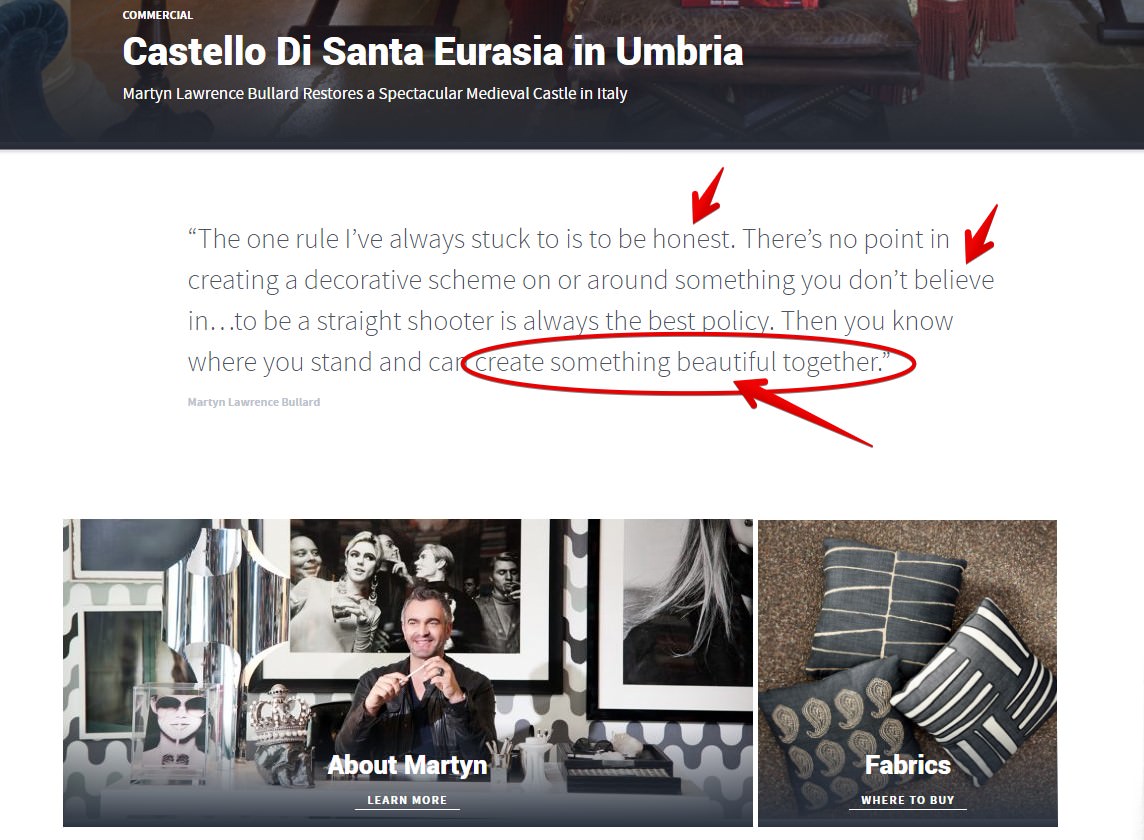
Generally large firms with big budgets, have spent thousands of dollars on focus groups, market analysis and very expensive copy writers.
So feel free to “grab” these ideas which have cost companies a small fortune.
They have done this because they understand how important it is to speak only to their “ideal client’s persona”.
They don’t care if their words and marketing don’t speak to everyone. They only want to attract a client that fits perfectly with their business.
To help a little more, check out the this list of famous design firms
Once you have created a persona and a list of all the qualities your ideal client finds value in, you can use this insight to craft your own unique story.
Sharing your unique selling proposition in the right way will attract more of the people you want to work with.
And in the next section I will show you exactly how to do this.
#4. Let your story sell for you
Your story can be the best sales pitch imaginable.
I want to introduce you to Aaron Draplin.
He told his story through a video a few years back and it went viral.
The interesting thing was it wasn’t super exciting, there wasn’t some amazing platform he told his story from and he did it all through a simple challenge.
To design a logo from scratch.
Aaron explains at the end of his video, why he does what he does, why he continues to work as a designer, even through tough times in his career.
The love of creating and helping his ideal client made him so likable that more people simply wanted to work with him.
Can any other graphic designer do similar work he does? Yes.
Can any other graphic designer tell his story? No.
Therein lies the big difference that separates him apart from the rest. Aaron’s story makes him desirable to work with.
He is the only one that can share his reason why he does what he does and the reasons he provides automatically builds trust, quality, care and attention-to-detail to his brand.
His passion for design is infectious, even I want a new logo now!
Don’t be afraid to share your authentic story and the processes you go through to deliver a quality job every time, Just like Aaron did in the video above.
If you are concerned that your story is not different from everyone elses, the next section will solve this problem for you.
#5. What a beer company did to stand out from the crowd.
Let’s say you are a landscape architect for instance and a client has called you up, you visit their tiny inner city “backyard” and have limited room to work with.
You instantly think that most designers would come up with the same ideas for the space as you.
And you may feel that you won’t stand up to the pack of ideas and quotes the client is receiving from other firms.
This is your chance to shine and explain the detail you would go through that other designers would simply skim over when pitching for work.
Introducing Schlitz Beer
A famous beer company in the early 1900’s went from the 5th most popular in America to reach sales within the #1 beer company in a few short months.
Heading the advertising campaign which made this possible was a famous marketer named Claude Hopkins.
Claude shared the story in his advertisements of what made Schlitz beer so ‘pure’.
And he did this in great detail with words such as:
“All beer is cooled in plate glass rooms using filtered air.”
“Dripping over frigid pipes”…. “It is sterilized before being bottled and sealed.”

This was just a sample of his entire advertising campaign.
By going above and beyond to explain every step Schlitz Beer went through to produce a quality product, Schlitz Beer became the #1 Choice.
Now, here is the funny thing: Most beer was made in exactly the same way at the time.
All competitor’s beers went through the same filtration process and they all took the same time to brew.
However, no other competitors explained this detail to their customers.
The other beer companies simply didn’t think it was important to share.
They felt it didn’t set them apart because everyone else was doing the same thing, so why bother explaining it?
This is what Claude understood that nobody else did.
He explained the process to make “pure” beer to his ideal customers. This created a perception that Schlitz beer was far more valuable than the others.
Once the other beer companies caught on to Claude’s ads it was too late… It would have looked like competitors were just copying Schlitz if they told the same story again.
After reading a detailed account of the countless steps that Schlitz goes through, why wouldn’t you choose the product that appears to go above and beyond?
It is worth noting though: You don’t want to bore people to death.

You probably don’t want to waffle on about how bricks are made, or what the best time of the year is to plant ferns.
By taking a page from Claude above you can explain the details that make up your design process to potential clients.
You can share specifics for how a clients dream can be realised with points such as these below:
> Creating 20 small sketches on a pad before culling 15 ideas.
> Transferring those 5 sketches into full colour
> Combining these 5 coloured sketches to make 2 or 3 great ideas come to life.
> Use software to come up with a solid plan.
> Create a plan in perfect order so everything will be project managed specifically.
> Craft your work with minimum expense and time delays so nothing will be left to chance.
Exploring this type of detail with clients is important.
NOTE: Share only the details that mean something of value to your ideal clients.
Let’s recap so far:
1. You understand the foundation of revenue for your business
2. You have created an ideal persona of your target client
3. You have crafted a story to align yourself to your ideal client.
In this next section I cover the marketing strategies in detail.
#6. Crafting the best lead-generation tool
Ok, so now we can create the system to entice your dream clients forward.
All firms that continue growth year on year, have a lead generation tool which entices potential clients to work with them.
However, not all lead generation tools are created equal.

A lead generation tool is something of value given in exchange for a person’s details, be that an email or a phone number.
Because you’re building your potential client list, you want to make sure that your “giveaway” actually fixes a real problem that your ideal client has.
For instance don’t create an ebook on “7 Ways To Save Money On Wall Art” when your dream client is not price-conscious.
After examining the qualities of your ideal client, you might notice that a better giveaway might be: “7 Ways To Modernise Your Home” instead.
Richard Petrie had a New Zealand architect deploy a giveaway following this exact example.
Because this particular architect focused on historical home renovations in New Zealand, she organised a booklet about the “7 Mistakes People Make When Renovating”.
The key Richard mentions is that this architect knew her target audience very well.
It was no accident that her lead generation tool had this title.
Next, she gave away this report by booking a booth at a local trade show.
After just one weekend, she received over 100 leads to her database.
More importantly; the leads she received were highly targeted.
The added bonus of always giving first
The famous lecturer Robert Cialdini cites a study about Hare Krishna followers and how decades ago they used to beg for money at airports in the US.
When you beg for money it tends to repel people.
The Hare Krishna’s noticed this so they changed their approach.
They started simply giving people smile stickers, like this one below:

They stopped begging for money, in fact they stopped asking for anything.
They just smiled and handed people a sticker as they walked by.
You know what happened?
They raised millions of dollars this way.
The reason Cialdini states is the “Law of Reciprocation“.
When someone gives you something for no reason, we as human beings feel the urge to want to give something back.
In the case of the Hare Kristina example, people gave them more loose change.
Think about your Ideal client, your story and the words you use to share with them.
Now take this information to brainstorm the idyllic form of content you can create to give to your target persona.
Your own “Smile” sticker might be an ebook, a report or even a simple infographic.
After you create your first “lead gen” piece of content, you want it to have the highest chance of going viral among your target market.
This is done through specific blogging strategies.
(Lower in this post I will share an example of how an infographic I created in my consulting days went viral).
You will learn why it went viral and how it continues to drive leads to this day.
#7. Blogging – Not like you think: When time spent writing means money now
I have spoken to many interior designers over the years about blogging and marketing their company.
This is what relatively unsuccessful companies mention:
“The market is saturated”
“There is no point in blogging”
“Nobody reads our posts and it takes too much time to write”
And trust me; I get it!

However the majority of people who blog, simply spend a lot of time writing content, pop it on their website and just leave it there… (cue crickets).
They might share the post on their social media platforms, but that is as far as their marketing strategy goes.
I want to share with you a way of blogging that you may not have thought about before.
The idea is to view each blog post you write with a clear and concise purpose of adding value.
So how do you do that?
Here are the exact steps you need to take to ensure blogging works for you:
Instead of only thinking a blog post is an article you write to appear more credible or help with branding your business. It would be better if you created a post that had a direct effect on the traffic received to your lead gen offer (mentioned earlier).
Below you will discover 4 types of blog posts that you need to focus on when starting out.
1. The Round-Up Blog Post:
Like www.Finder.com.au did years ago here
They created a ‘round-up’ of the top 25 popular finance bloggers at the time.
After they created this list they personally emailed the 25-bloggers mentioned in the ‘round-up’ encouraging them to send it to their audience.
When someone (who is not a competitor) lists you as a “top” of anything, it makes sense to share this content with your followers. So it isn’t only you, saying how good you are 🙂
This spread their website across established audiences and in front of new people that Finder.com.au identifies as their ideal clients. People who need help with their personal finances.
How will this type of post work for you?
Let’s say you are an interior designer in Australia. You could create a blog post highlighting your favourite landscape designers.
This list would contain 25 of your favourite Australian landscapes and the designers of them.
After you create this list you then reach out to these landscape designers with an email like this:
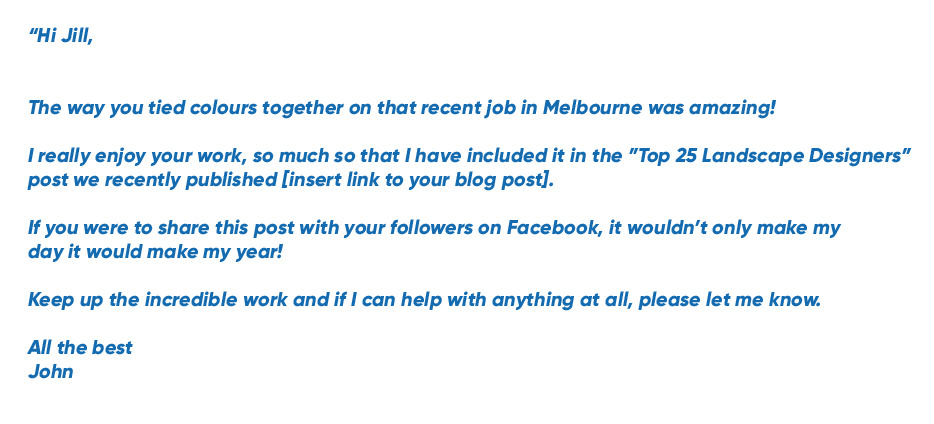
What you are doing is providing value through your blog post by calling out outstanding people who are great at their job.
By giving them recognition for their work, they are much more likely to share this post with their audience.
Below, this post went viral, by doing the exact same thing in a completely different market:
Image Source: Screenshot – Smallbusinessideasblog.com
Now, if these audiences are keen to spend money on exterior design, do you think they would be interested to spend money on the inside of their homes as well?
It’s likely they would.
I want to share another example of this type of blog post so you can get even more ideas.
Years ago in my past consulting days I helped promote a vegan blog. We listed the top 15 vegan meals for Breakfast the top 15 meals for lunch and the top 15 meals for dinner in one post.
After creating this list we went to work promoting the post with a simple email to all 45 website owners that went like this:
“Hi Paula,
We love your website, so much so we have included your avocado and roast tomato recipe on our top 15 meals for breakfast!
Check it out here: www.yourwebsite.com.au/top-meals
Thank you for supporting the vegan community and putting out such great content.
Feel free to share this link through your social media channels and if we can do anything else for you do not hesitate to reach out.
Cheers
Dean”
The incredible thing is people started to share it across multiple platforms…

The key is to not sound salesy or trying to push your agenda onto other people.
When you link out to someone like this and let them know. You are giving someone a compliment.
It makes them smile and they generally want to share this post.
No need to use any scummy sales tactics to spread the word about your website/business.
Within 2 days this post had over 340 Facebook shares 200 retweets and it was emailed to people countless times, I can’t remember the exact number, but it was huge.
Now the website was on the radar of 1000’s of people who had a direct interest about the topic on hand.
And most importantly it cost $0 to reach more of their target audience.
2. “Question” Posts
This is where you ask the same question to 10 influential people in your field – And post their answer in one article.
Once again, instead of reaching out to direct competitors, reach out to other people in your field who would attract similar audiences you want to attract.
An example of such a post is can be seen here

Once again; you publish this post and share the link with ‘contributors’ in an email and let them know they are welcome to share it through their social media channels.
Be sure to end your post with a little blurb about how you help clients too.
It is best to write a blurb which focuses on elevating a pain point of your dream client. And why you are an expert at solving that particular pain point.
3. Infographics
Infographics are a graphic representation of facts.
Instead of creating a blog post with only words you can display information in a picture format.
We can generally digest more information if it shown in to us in pictures (visual) as opposed to words.
And the idea of creating any form of content such as an infographic is to drive traffic to a lead generation offer on your website.
By crafting content directly related to your ideal customer and making it interesting it can spread like wild fire.
When I consulted for a trucking insurance company years ago I had an infographic created.
It listed the “top hauls” pulled by trucks across the world.
Clearly this would not be of any interest to most people, however to their ideal customers (trucking company directors and truck drivers), it certainly was.
First step was to do a little research using Google and YouTube.
I then aggregated the content.
I used Fiverr to find people who put it together into a graphic for my client. (Jobs on fiverr.com start at USD $5 each and are a great way to shortcut putting infographics together).
Here was the result:

After this graphic was created, I submitted it to visually and Graphs. Then I went to work by finding Facebook groups who were interested in trucks.
I found some conversations going on and shared the link of the infographic to these online groups. Using a message like this:
“Hey guys, love this Facebook group about trucking and thought to share this infographic.
I have seen trucks move houses before, but had no idea they could move things as big as this!”
This generated 1000’s of visitors and many leads to the trucking insurance website.
After a few months it even reached a trucking journal who asked my client if they could re-publish it in their publication (which they did).
They drew a lot of business from this one image.
It crossed the world countless times and to this day, years later it still gets shares.
Infographics for your industry
To relate this back to us.
Say you specialise in fit-outs for Legal firms, you create an infographic for the “10 most expensive legal firm fit-outs”.
You can then email this out to your clients – your prices will also look cheap in comparison (wink-wink).
Next, you share the same infographic on your Facebook page and reach out through Facebook groups (non-competitors) who share your target audience.
You can even post the infographic on LinkedIn and share it through existing LinkedIn Groups.
NOTE: Seeing a large amount of social shares on your website generates an instant feeling of credibility as well.
Once you notice a decent number of shares on your website – Email out to past people you have collaborated with and share with them the “success” this post received.
Aligning yourself with the ‘popularity’ of the post creates a sense that you are the go-to person on the subject.
I would then share the post with other indirect competitors, those who specialise in fit-outs for schools, hospitals or tech companies for instance.
Since they are not direct competitors they wouldn’t see any reason not to share this. Helping you with referral business.
You are building an online network which directs back to your lead generation capture form already set up.
(Coming up next) – I would consider this one of the fastest methods to grow your business quickly
#8. Using relationships in your industry to earn more today
Do you really need two real estate agents to sell a property?
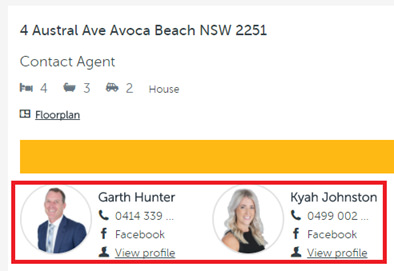
No, but when they combine their reach of clients they both win in the end. The same goes when you collaborate with other firms.
But, how can you just work with other firms?
Jay Abraham a respected marketer, worked with a large nursery which had been operating in his local area for years.
They had about 3,000 customers on their books.
After looking into the buying habits of these 3,000 customers they noticed 80% of the business’ revenue came from just 500 of these people.
Jay spent time teaching this business owner that these 500 ideal customers who are loyal to their nursery have other jobs to be done, such as pool cleaning along with ordinary garden and landscaping maintenance.
So they designed a package deal to offer these ideal customers.
Packages for landscaping, pool cleaning etc…
Gathering together local trades, the business owner of the nursery paid these tradies their regular fees then added a fee on top as the compensation for bringing all these various services together and making sure the job was done right, to a high standard he expected.
He basically crafted relationships to be a middleman or broker using the brand, he had built up over the years.
He then presented the offer to his loyal clients and this resulted in close to $200,000 of revenue that didn’t exist the year before.
Jays mentions: “There is always a gap in the market and value to be attained”
Now, if you don’t have a large firm and can’t use your brand name to sell a new package this strategy still works.
Say the phone rings and a person asks for help with office colour schemes (and you have no interest in this job)
You can say:
“Thank you for calling, I know I can’t help you with this as we specialise in other things however “ABC company” can and they normally charge “$1000” for the service. However if you mention to them that I sent you, they will only charge you “$850” and offer a complete warranty on all work carried out.
I highly recommend them and know that they will do a great job”

Obviously, you would have to arrange a deal with other firms first before making any promises.
However, this strategy always works both ways.
If you help them, they would want to help you and send work your way.
By building channels similar to this example, you are adding value to your clients and helping future customers by being able to offer a much greater range of services.
Recall at the beginning of the post; if you can have clients come back to you more often during the year your bottom line increases exponentially.
Find these types of win-win scenarios to help customers get what they want. When you help other businesses flourish it is never a bad thing.
This isn’t just good Karma, this is good business.
Next… You will discover how to take Host-Beneficiary partnerships to the next level.
#9. Doing pro-bono work for a great cause while earning revenue.
Years ago, at a marketing seminar run by Brendon Buchard, he explained his approach to working with non-for profits to help them and build his business at the same time.
The idea is so simple, yet so powerful I had to share it with you here.
Each year large companies in Australia want to support the community, they do this for good will, yes, but they also do it for the tax breaks and for branding purposes.
For instance, JB-Hi Fi is one of Australia’s largest contributors in the for-profit sector to charities each year.
Over the past 10 years they alone have donated $10,000,000+ to charities such as The Fred Hollows Foundation and Oxfam.
And of course there are countless other for-profit businesses like this that donate huge amounts of money each year.
Brendon, would find these large companies and go through their Press Releases or website content.
Highlighting any time, the CEO of the company mentioned anything to do with the local community and “initiatives” they planned to roll out during the year.

These companies already have huge sums of money set aside to give away for causes they want to align their brand with.
Brendon would simply get in touch with the marketing departments of these companies (using LinkedIn).
Acting as a “Middle-Person” he would create an event for example to promote his business, the charity and the for-profit company all in one.
All while having the large for-profit business pay for the event and the promotion for the event.
In return they “sponsored” the event and were able to advertise their products, not to mention receive a large tax-write off for benefiting their local community.
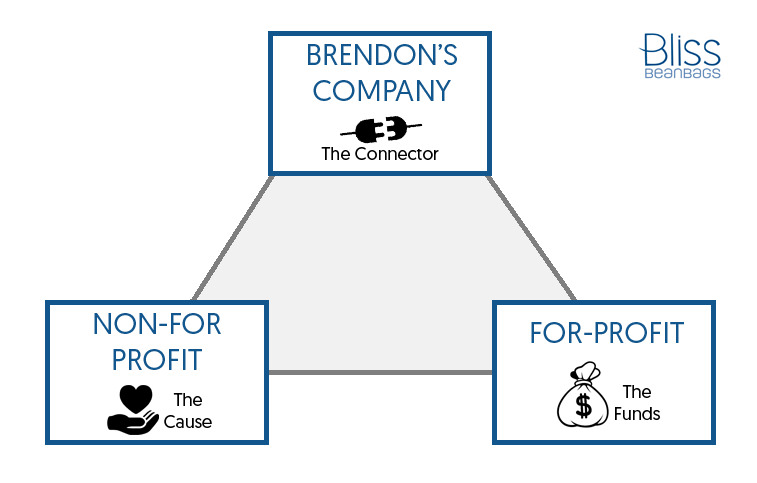
In a real life example these were the steps he took:
1. He found a large company whose goals aligned with helping under privileged children.
2. He found a charity from a list like this which aligned with the message in a book he created.
3. He pitched the whole event and the publication of a book to a large for-profit company and got them to pay for it all.

Fulfilling the CEO’s requirement for donations that year.
He explained that the event was already planned and how it was going to look to the large corporation.
He then shared the opportunities (apart from the tax breaks) the large corporation would benefit by aligning their brand with non-for profits and the people at the event.
Sharing the event on their social media channels, having their brand directly related to a cause that aligned with their target market.
The idea here is to match the goals of large companies with those of non-for profits.
You as the “middle” person simply creates a function, event, educational seminar, publication etc… That puts you right in the spot light in front of your target audience.
Something like this will put you on the map in your local community as well.
Any local paper would be happy to cover any function you are planning.
If you want to find even more reasons how this works see this post.
Even dialing this strategy down still works wonders.
If you didn’t want to do something on such a grand scale you can accept pro-bono work as a way to expand your reach among peers in the community to get more referrals.
The service you provide as an architect or designer is HUGE for the community.
This worked wonders for us (Bliss Bean Bags) and another design firm as well.
Steve from Outhouse design was called up by Royal Randwick Children’s Hospital to create a beautiful garden for the kids. (Pro-Bono work)
Not only did he showcase what amazing work his team carries out, they were able to help children in times of need.
Steve called on us to create some personalised bean bags for the project. It was a great deal of fun and unlike most common networking events we had the chance to work with many other contributors that were all part of the project.
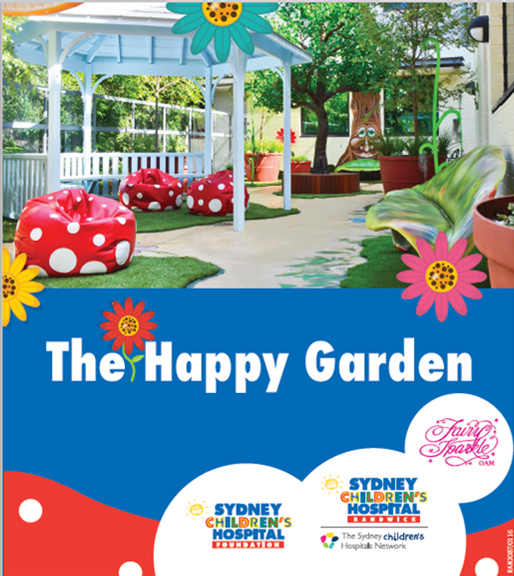
We have had direct business come from people seeing our kids bean bags at the hospital. And we are forever grateful to Steve for allowing us to be part of the project.
And we have already recommended his company Outhouse Design to people who are looking for precise landscape work when they ask about the garden as well.
Not just because he is a great guy. But because at the opening of the garden I was blown away by the final result.
And here I am again, telling you about it.
Nothing beats the credibility of word-of-mouth marketing.
Be genuine when creating opportunities like this for others.
Out of kindness, Steve and his team created something that will benefit thousands of people.
And they created a scenario where:
1. Multiple relationships were formed.
2. Positive word-of-mouth was created for their business.
3. And they had the chance to work on something truly meaningful.
#10. How to use industry awards to make more money
If you view industry awards in the way I am about to show you, they will mean instant credibility and revenue to your firm.
Firstly, get to work creating a calendar over the next 12 months for every award you are eligible for within your industry (preferably awards that count on getting votes from outsiders).
Then set reminders for yourself.

Be sure to schedule, apply and submit your work on time.
Turn these submissions into compelling stories sharing most importantly what benefits the client got out of your work.
There is an old saying when it comes to selling anything (including yourself).
“Don’t sell the vacuum cleaner, sell the clean house”.
Secondly, compile a list of similar awards that you are not eligible for, because they celebrate companies that are outside your scope of work.
Now reach out to these other firms not directly in your market who can apply for these awards.
For instance, if you specialise in fit-outs for schools, reach out to architects who only work with hospitals and tell them you love their work and they should apply for the “ABC” competition coming up.
Give them the details and ask them if they need your help in submitting.
(I will get to why this is important in a second)
You can send an email like:
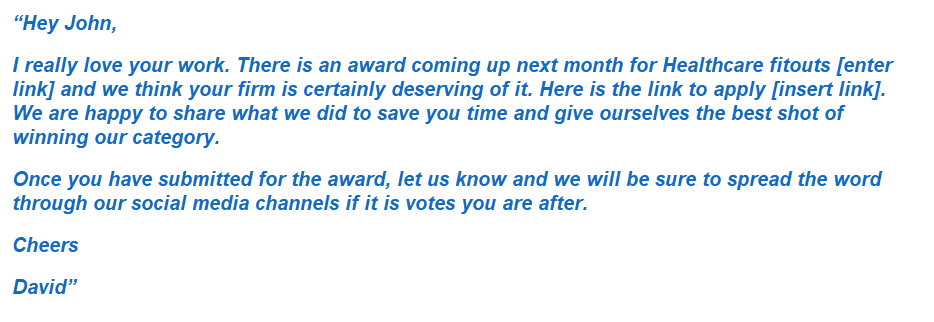
Every time you apply for an award, share the love through your social media platforms.
After you have done this, reach out to the same firms you encouraged to apply for awards in their niche.
They will be happy to “spread the word” for you as you did something for them first.
There is nothing like social proof to build the strength of a brand and get votes, even if you are a one woman or man show.
Once again, even if you don’t win the award, the worst-case scenario is you are put on the map with your peers.
The law of reciprocity (mentioned earlier in the post) kicks in and you will be front-of-mind when a referral comes across their desk for the work you specialise in.
Therefore help as many indirect competitors as possible.
Unfortunately, doing good things for others is rare these days.
Because it is rare though, people won’t forget when you helped them out.
#11. Social media marketing for architects and designers
Who has the time to manage all forms of social media?!
This section will highlight what you need to focus on and how to make the process of managing social media as streamlined as possible.
Being in a client based, service business you are better off ignoring a lot of social media platforms and just sticking with:
• Facebook: Due to the incredible way you can target your ideal customer
• Houzz: Made for designers and architects
• Pinterest: The visual impact of carefully crafted boards is huge
• Instagram: Yes, Pictures will always tell a thousand word.
You may have been told by others that the key to social media working for you is consistency.
Consistent posts show trust and loyalty to your clients and prove you follow through with what you set your mind to.
Nothing looks worse than a Facebook page which hasn’t been updated in a year.

The issue is before you begin working on social media to generate more revenue you need a system in place. And this system needs to be as efficient as possible, so you have the best chance of being consistent and reaching more of your dream client.
The simple system to promote your business on social media
Going back to the example of a blog post mentioned earlier.
Where we created a round-up of influential peers and listed the top 25 designers you loved the most.
You now want to take out a line from this blog post of something that stands out and would be interesting to your audience.
Let’s say for instance landscape designer number 12 on your list had something great to say on their website.
Perhaps a personal quote that inspired you.
Take that line and mention it on your Facebook page (crediting the designer you received it from of course).
Then take this same line and craft a great background something that may look like this:
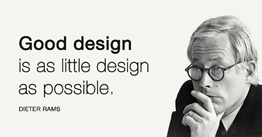
Then post this image on your Instagram account, linking back to the same blog post where the quote came from.
Take the same image and then create a “mood board” inspired by the quote on Pinterest.
Again, if you simply don’t have the time find someone on Fiverr to help you out.
Have the link on your Pinterest account direct back to your lead gen form on your website.
Take this same mood board and create a guide on Houzz.
Only actual contributors can post real stories and guides, but you can make your own “unofficial guides” by creating an idea book with gorgeous images that anyone can see.
For a great guide on setting up you Houzz account click here.
Saving You Time
The idea shared here is by using one piece of content from your blog post you are able to break it up to suit the various platforms on social media.
Thinking of it this way means you don’t need to spend hours creating content for each social media company.
You are ‘translating’ the content into the language best suited for each social media platform.
Once you do this a few times you will notice which posts on various platforms will be more popular that others, so be sure to save yourself even more time and re-post the exact same popular content on Facebook and Instagram again.
You heard that right – so many people who like your page will have missed the popular posts the first time. So be sure to post it again about 3 to 4 weeks later… Since you already know it will do well with your target market.
One extra bonus.
Knowing which posts are popular means they will likely be popular on related Facebook groups as well.
Say for instance you are an architect specialising in extensions for historical homes.
Find Facebook groups and popular blogs related to antiques, classic homes and Victorian architecture and ask to join them if it is a closed Facebook group.
Then post your most popular posts with these groups and join conversations on other comment threads.
Once you have done this a few times, people on the group will look forward to your posts.

This is when you create a specific post on the Facebook groups you have contributed to.
Add greater value to the group by starting a discussion around your specialty.
After you have left a lot of helpful comments the Facebook group owners will be much more receptive to offering you a guest posting opportunity to share your ideas as well.
You can relate a case study from a past client and how you were able to solve a problem they had.
People on this group will love the knowledge you share and more importantly; you are sharing with people that fit the persona of your ‘ideal customer’ you want to work with. (Since you have already done the work, the content you create won’t be hard to compile together).
People love case studies, they are one of the most popular forms of content shared on the web.
Once you get consistent feedback from these groups, be sure to start your own group directly related to your niche if it doesn’t exist.
Invite everyone from the multiple groups you have posted on to join yours. You are effectively creating your own focus group to bounce ideas off now.
Not to mention crafting an automatic fan base of people you wish to serve most.
To recap:
Be strategic with social media. Save yourself time by outsourcing content creation if possible using a website like Fiverr or UpWork and repost what is already working.
• Be consistent with posting.
• Reuse popular posts on other social media channels and post them again after 3 to 4 weeks
• Craft conversations that will benefit those on Facebook groups and blogs.
You don’t want to post for the sake of it, you want to post with a higher purpose in mind.
Focus on where your ‘dream clients’ live online and show them they would be lucky to work with you.
There has simply been no easier or cheaper way in history to target the right people. So enjoy the process.
#12. Understanding the “Pillars” that hold up successful firms and how you can copy them

Most people in the architecture and design game have made a name for themselves over time, they have built up relationships that have taken years to foster and now they are a trusted source in the industry to take on more projects.
They expect and rightly-so that word of mouth is all that is needed to ensure their business survives and hopefully continues to thrive.
The issue with this one marketing strategy is that their entire career is built upon one pillar which holds their business up.
Now if you were to build your house with just one pillar to hold up the entire foundation, you wouldn’t be able to sleep at night.
You need to create more pillars to hold your business up, greater forms of marketing strategies represent these pillars and can be just as strong as word-of-mouth to bring in new business.
The best pillars are the ones which have a knock on effect. Meaning they:
1. Help you gain more clients,
2. Help you develop relationships with your clients for repeat business
3. Help generate avenues to increase your revenue.
Small increments in each of these areas means a strong thriving business and enables you to raise above the competition and own your niche.
It also means during slow periods in the economy you won’t be as affected.
As other business’ in your field come and go you will stand nice and tall.
Be sure not to just rest on word-of-mouth marketing without exploring the strategies and examples mentioned above.
NOTE: you only need to be slightly successful in each of the marketing strategies spelled out above to have a cumulative effect that is HUGE.
Conclusion:
Have the intention with every potential client that you simply want to make them feel better for meeting you.
Focus on your client’s aspirations. Their needs and wants to have more, be more and create a space they are truly proud of.
The genuine spirit of wanting to add value will come through and simply increase your chance of working with them.
Ultimately every ideal client you want to work with is really asking one question:
‘Why should I hire you?’
You job is to answer that question through a story that solves their pain point(s).
Remember that directing content around your dream client and being consistent with it will build greater trust for your firm.
Think outside the box and help businesses that share similar interests to yours. This helps with word-of-mouth and builds credibility with peers in your industry.
Create strategic partnerships with businesses to benefit all involved such as the pro-bono example above. And Connecting not-for-profit foundations with for-profit businesses to create a win-win scenario
Remember to have fun doing this!

A wise man once told me that at the end of your life you don’t remember the money you made or the things you spent money on, but you remember the relationships you formed… Perhaps the richest experience of all.
I sincerely hope this post helps to build these great relationships and earn more business in the shortest possible time.
Take the lessons learned from the most successful firms and have fun taking your business to the next level.
If I can help in anyway at all, please leave a comment below or reach out through the contact form here

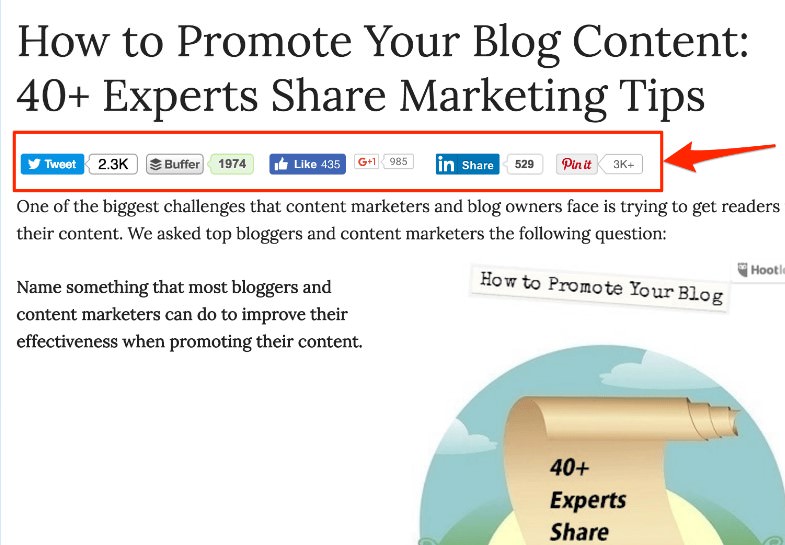 Image Source: Screenshot – Smallbusinessideasblog.com
Image Source: Screenshot – Smallbusinessideasblog.com